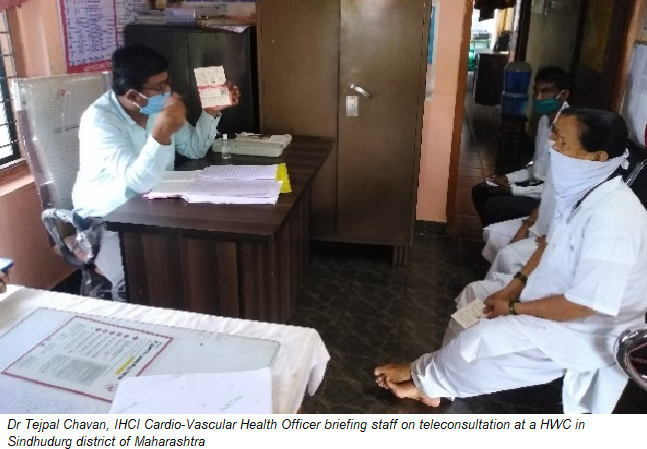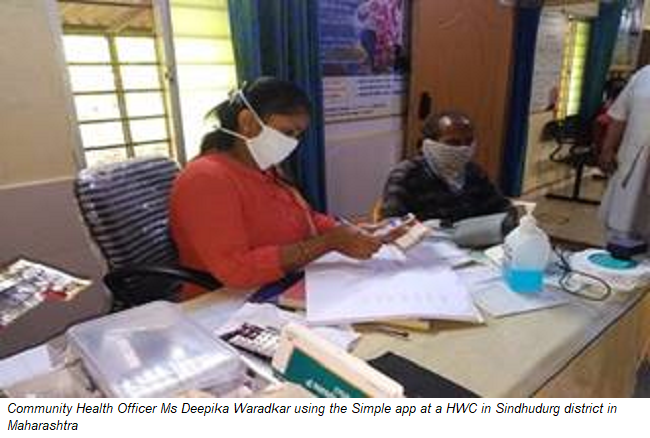When India implemented a nationwide restriction on mobility or “lockdown” to prevent the spread of COVID-19 on 24 March 2020, millions of people with chronic diseases such as hypertension (chronic high blood pressure) and diabetes found themselves unable to access treatment. Even after mobility restrictions were lifted in a phased manner from June, social-distancing and the fear of getting infected kept people from accessing out-patient services for routine follow-up care at primary health centres (PHCs) or hospitals.
In India, an estimated 260 million people over the age of 18 years have hypertension, according to the National Non-Communicable Monitoring Survey (NNMS) 2017-18 done by Indian Council of Medical Research (ICMR).
Frontline workers at Health & Wellness Centres (HWCs) located closer to the community are not authorized to diagnose or adjust hypertension and diabetes medications without consulting a medical doctor. This meant rapid action was needed to address gaps and ensure continuum of essential health services.
The solution came in the form of an innovative intervention from the India Hypertension Control Initiative (IHCI), which is a multi-partner initiative of the Government of India’s Ministry of Health & Family Welfare, ICMR, WHO Country Office for India, and Resolve to Save Lives. IHCI aims to contribute to India’s target of reducing the prevalence of hypertension by 25 per cent by 2025.
Under the initiative, a team of IHCI cardiovascular health officers and senior treatment supervisors from WHO-India is supporting 13 state governments to develop and adopt state-specific hypertension treatment protocols, streamline forecasting and procurement of anti-hypertension medicines, build capacity of health care providers, and establish cohort-monitoring through effective information systems, including digital apps like ‘Simple’.
The Simple app for hypertension management has been upgraded to include telemedicine for delivering services at the community-level in accordance with the Government of India Telemedicine Practice Guidelines 2020. A pilot project was implemented in nine districts of Maharashtra and Punjab in June.
“The introduction of telemedicine through the IHCI is both a pragmatic response to COVID-19 and a patient-centered strategy. Its effective implementation will guide the scale-up of services to other districts in India to enable the continuum of care for hypertension patients,” says Dr Roderico H. Ofrin, WHO Representative to India.

Telemedicine through the Simple app was initiated at 336 HWCs and sub-centres in June for the management of high-risk patients and those unable to reach PHCs and higher facilities. Around 1200 health care workers, including medical officers (MO), staff nurses, community health officers and auxiliary nurse midwives (ANMs), were trained to use the Simple App to access a patient’s profile and request tele-consultation with a medical officer via WhatsApp or text messages on their smartphones.
After consultation with both the patient and healthcare worker via phone, video or text message, the MO sends an e-prescription with guidance on administering the appropriate dosage of medicine. About 2719 teleconsultations were conducted from June to August 2020 in select health facilities.
“In Sindhudurg, many people with non-communicable diseases were facing difficulty in reaching PHCs due to lack of transport. Our health staff at HWCs and sub-centres can now give follow-up care to patients, especially those with uncontrolled blood pressure readings, by contacting their medical officers through the Simple app,” says Dr Mahesh Khalipe, a government District Health Officer at Sindhudurg.

Patients are already experiencing the benefits. “During the lockdown, I could not get my blood pressure measured at the primary health centre (PHC) in Banda, which is quite far from my home. Now, staff from a government health sub-centre delivers the medicines to my house. I have also started visiting the sub-centre since October to get my BP checked and collect free medicines,” said Mangala Devi, a 61-year-old patient with hypertension from the Sindhudurg district in the state of Maharashtra.
Given the success of the project, IHCI is now scaling-up telemedicine services to other districts in India.
